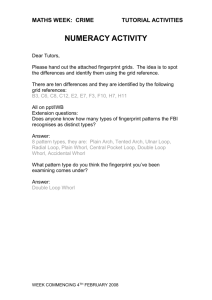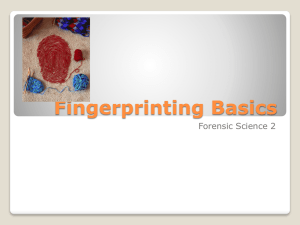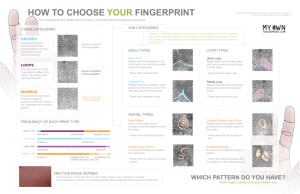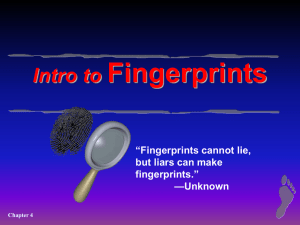fingerprint principles fingerprint classes interesting info arches
advertisement
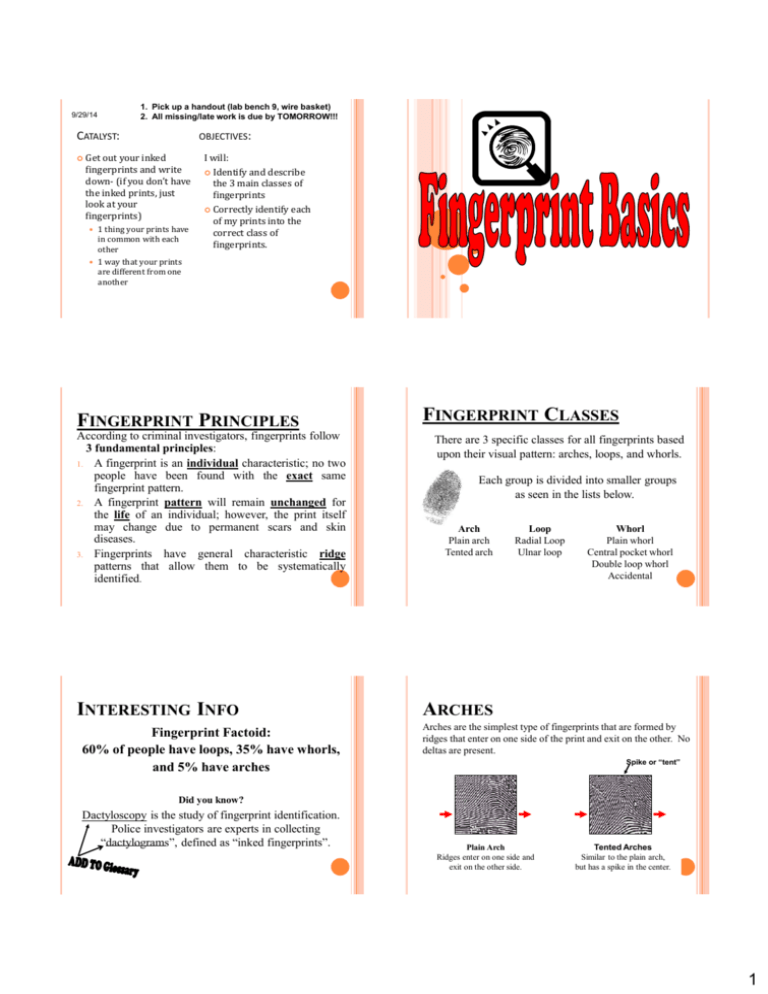
9/29/14 1. Pick up a handout (lab bench 9, wire basket) 2. All missing/late work is due by TOMORROW!!! CATALYST: OBJECTIVES: Get out your inked fingerprints and write down- (if you don’t have the inked prints, just look at your fingerprints) 1 thing your prints have in common with each other 1 way that your prints are different from one another I will: Identify and describe the 3 main classes of fingerprints Correctly identify each of my prints into the correct class of fingerprints. FINGERPRINT PRINCIPLES According to criminal investigators, fingerprints follow 3 fundamental principles: 1. A fingerprint is an individual characteristic; no two people have been found with the exact same fingerprint pattern. 2. A fingerprint pattern will remain unchanged for the life of an individual; however, the print itself may change due to permanent scars and skin diseases. 3. Fingerprints have general characteristic ridge patterns that allow them to be systematically identified. INTERESTING INFO Fingerprint Factoid: 60% of people have loops, 35% have whorls, and 5% have arches FINGERPRINT CLASSES There are 3 specific classes for all fingerprints based upon their visual pattern: arches, loops, and whorls. Each group is divided into smaller groups as seen in the lists below. Arch Plain arch Tented arch Loop Radial Loop Ulnar loop Whorl Plain whorl Central pocket whorl Double loop whorl Accidental ARCHES Arches are the simplest type of fingerprints that are formed by ridges that enter on one side of the print and exit on the other. No deltas are present. Spike or “tent” Did you know? Dactyloscopy is the study of fingerprint identification. Police investigators are experts in collecting “dactylograms”, defined as “inked fingerprints”. Plain Arch Ridges enter on one side and exit on the other side. Tented Arches Similar to the plain arch, but has a spike in the center. 1 LOOPS Loops must have one delta and one or more ridges that enter and leave on the same side. These patterns are named for their positions related to the radius and ulna bones. ULNA Delta Radial Loop Loop opens toward the left or the radial bone (or towards the thumb). RADIUS Ulnar Loop Loop opens toward right or the ulna bone (or little finger). NOTE: On the left hand, a loop that opens to the left would be an ulnar loop, while one that opens to the right would be a radial loop. WHORLS – PART 2 WHORLS Whorls have at least one ridge that makes (or tends to make) a complete circuit. They also have at least two deltas. If a print has more than two deltas, it is most likely an accidental. Double Loop Whorl Central Pocket Whorl Plain Whorl Accidental Whorl Delta Delta Double loop whorls are made up of any two loops combined into one print. Draw a line between the two deltas in the plain and central pocket whorls. If some of the curved ridges touch the line, it is a plain whorl. If none of the center core touches the line, it is a central pocket whorl. Accidental whorls contain two or more patterns (not including the plain arch), or does not clearly fall under any of the other categories. IDENTIFY EACH FINGERPRINT PATTERN. IDENTIFYING YOUR OWN PRINTS 1. 2. 3. 4. Get out your fingerprint card Identify the type of print you have, write your answers in your comp book (My fingerprints lab) Use a magnifying glass if needed Use the Sirchie Booklet if needed (pages ) Right Hand Left Hand 5. 6. 7. Find a partner (nearby, don’t get up and move) Swap fingerprint cards Examine your partner’s card, see if you come to the same conclusion Right Hand Right Hand Left Hand 2 CLOSING QUESTION Write your response to the quote below: 3
